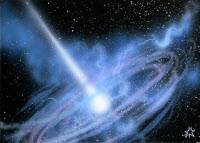 It's as recent as 1972 when the first black hole was discovered (Cygnus X-1, by American Astronomer Charles Bolton). This cosmic annihilator is now firmly rooted in popular understanding of the universe; but the mathematics of Einstein's General Relativity, which theorised about black holes, can also hypothesise the existence of its inverse twin, the 'white hole'.
It's as recent as 1972 when the first black hole was discovered (Cygnus X-1, by American Astronomer Charles Bolton). This cosmic annihilator is now firmly rooted in popular understanding of the universe; but the mathematics of Einstein's General Relativity, which theorised about black holes, can also hypothesise the existence of its inverse twin, the 'white hole'.
The theory of time-travel through a highly unstable wormhole in spacetime (the "Schwarzschild wormhole") says that on the opposite side of a black hole which sucks in matter, exists a white hole which blows it back out.
But many physicists have argued that a white hole would violate the 2nd law of thermodynamics (which says that disorder always increases on large scales). And this might put the theory to bed for good... except that in 2006 Astronomers made an observation for which no satisfacory explanation other than a white hole has ever been put forward.
GRB 060614 was the longest Gamma Ray Burst ever observed. Said to be the brightest thing in the universe, a Gamma Ray burst can happen in the explosion which creates a neutron star or black hole. As Gamma Ray bursts reach us after travelling through space for billions of years, we see these quite often, but they last between milliseconds to a couple of seconds. GRB 060614 lasted 102 seconds, and not even the Hubble Space Telescope detected a supernova at its source.
And then in 2013, GRB 130427A was observed, also with no supernova observed at its source, and that Gamma Ray Burst lasted for hours!
Could these be the first observations of a white hole?
Further reading:
- EarthSky: Have we seen a White Hole?
- Ask an Astronomer: What is a White Hole?
Image Credit:
- Log in to post comments

